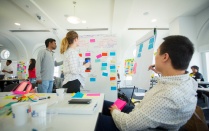Building Inclusive Environments

2016 Global Innovation Challenge focused on Inclusive WaSH
The 800 million people with disabilities living in low- and middle-income countries experience inequities in access to education, employment, and social services. While unjust policies and social stigmas impede progress, the lack of safe and accessible water, sanitation, and hygiene facilities is crippling. To empower girls, children with disabilities, and other vulnerable populations toward self-efficacy, we collaborate with global organizations like UNICEF, building socially inclusive policies, tools, and environments.
What is Inclusive WaSH?
By Kory Smith
More than 15% of the world’s population has some form of disability, 80% of whom live in low- and middle-income countries where basic needs, such as sanitation, often go unmet. The Community for Global Health Equity's Inclusive WaSh team has recommended and begun to test core questions to monitor WaSH in schools through the Joint Monitoring Programme for Water and Sanitation, the official United Nations mechanism tasked with monitoring progress towards the Sustainable Development Goals in WaSH.
Through the 15-year campaign to achieve the United Nations’ Millennium Development Goals (2000-2015), 2.6 billion people gained access to improved drinking-water and 2.1 billion people gained access to improved sanitation. As a result, throughout much of the world, efforts and investments can now be steered toward healthcare, education, and other public health initiatives. While universal access to improved water sources appears in reach through the Sustainable Development Goals, the next 15-year campaign, meeting the target for improved sanitation will be a challenge, as 2.4 billion people still lack access to improved sanitation facilities. Moreover, universal coverage in both sectors – water and sanitation – will not be met if the needs of marginalized and vulnerable populations are not addressed. As of 2015, for example, approximately 360 million people with disabilities worldwide lacked access to improved sanitation facilities.
Water, sanitation, and hygiene (or WaSH) programs are critical for promoting public health and are linked to economic development. WaSH projects have been central to international development efforts, managing humanitarian crises such as refugee resettlement, and the general advancement of rural and urban areas throughout history. Improving WaSH efficacy is not only about improving the quality and scale of infrastructure; facilitating adoption of, education about, and management of systems is also necessary. In addition, WaSH interventions, especially in low-income settings, need to meet the physical and psychosocial needs and preferences of marginalized and vulnerable populations – such as children, older adults, girls and women, and people with disabilities. “Inclusive WaSH” is a human-rights approach to planning, design, and implementation that improves access for these groups.
Not only does the lack of sanitation access place both these individuals and their communities at risk for disease but it also has hidden consequences. In India, for instance, more than a third of school-age children with disabilities are not enrolled in schools, and, in Uganda, 94% of students with disabilities drop out prior to completion. One reason is the lack of accessible WaSH facilities in schools. Likewise, in both countries, due to perceived and real threats of verbal and physical assaults, girls entering puberty are equally vulnerable to not completing school, again, due in part to the planning, design, and oversight of sanitation facilities.
Unequal access to clean, safe, and functional water and sanitation is evident at all scales – disparities from country to country, city to city, household to household, and individual to individual. Meeting the needs of disenfranchised populations is a major priority if we are to achieve the UN goal of “water and sanitation for all.” The barriers that impede success in WaSH projects are numerous – lack of funds, know-how, materials, and/or land, as well as issues regarding cultural norms, maintenance, and other factors. Much of the emphasis has been on technological innovation, but this is not the primary problem; there are hundreds of excellent water and sanitation technologies available, even in low-income settings. Experience shows that water and sanitation projects need to be comprehensive, not technology-focused, and community led, not predetermined, to be effective. The need is for innovative business models, innovative policies and funding strategies, innovative, culturally-resonant educational programs, and innovative methods for coordinating across geographies and sectors.
Definitions
According to the WHO/UNICEF Joint Monitoring Programme for Water Supply and Sanitation, improved sources of drinking-water include:
- Piped water into dwelling
- Piped water to yard/plot
- Public tap or standpipe
- Tubewell or borehole
- Protected dug well
- Protected spring
- Rainwater
"Unimproved" sources of drinking-water include:
- Unprotected spring
- Unprotected dug well
- Cart with small tank/drum
- Tanker-truck
- Surface water
- Bottled water
According to the WHO/UNICEF Joint Monitoring Programme for Water Supply and Sanitation, improved sanitation is:
- Flush toilet
- Piped sewer system
- Septic tank
- Flush/pour flush to pit latrine
- Ventilated improved pit latrine
- Pit latrine with slab
- Composting toilet
- Special case
"Unimproved" sanitation:
- Flush/pour flush to elsewhere
- Pit latrine without slab
- Bucket
- Hanging toilet or hanging latrine
- Shared sanitation
- No facilities or bush or field

Smith receives national book award for study of African city
Our Working Solutions

Students partnering with collaborator Asha Bamutaze at the Appropriate Technology Centre in Uganda
Our Team

Gauri Desai
Clinical Assistant Professor
School of Public Health and Health Professions
Email: gauriabh@buffalo.edu
Co-lead, Food Equity Team; Assistant Professor
Urban and Regional Planning and Community for Global Health Equity
Email: frimpon@buffalo.edu
Professor; Director of Undergraduate Studies, Environmental Engineering
Department of Civil, Structural and Environmental Engineering
Associate Professor; Program Director, Advanced Graduate Certificate in Assistive & Rehabilitation Technology
Department of Rehabilitation Science
107 Park Hall University at Buffalo Buffalo, NY 14260-4150
Email: rmuldoon@buffalo.edu
Founding Co-Lead, Community for Global Health Equity; Professor and Chair
Department of Architecture
Phone: 716-575-2874
Email: khsmith@buffalo.edu
Ryan Frederiks
UB Alumna
MS. Geology
Email: rsfreder@buffalo.edu

Zuwena Plata
UB Alumna
MPH. Epidemiology and Environmental Health
Our work is done in collaboration with many talented community partners. We list these partners on the affiliated project pages.












